Picture Prompts – Creating Art Journal Pages with Hand-Drawn Animals
This week, we use small collage pieces as picture prompts for art journal pages.
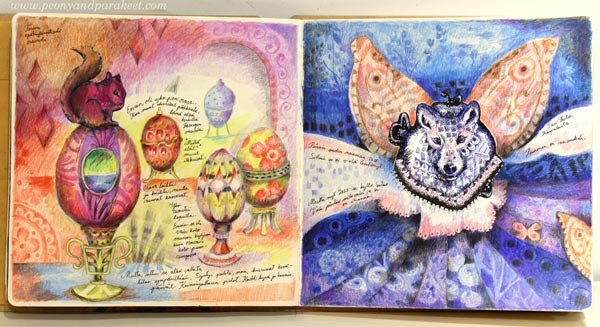
First you pick a small image, a hand-drawn squirrel or wolf in my case, and use that as inspiration for the rest of the page. You will need paper, colored pencils, and a pen for journaling. I also used felt-tip pens for the details that I wanted to highlight and graphite pencils for quick sketching. I attached the animals to the page with double-sided tape. My journal is Dylusions Creative Journal Square. (Affiliate link to Amazon.com).
Open Your Box of Joy and Select the Animal!
We will use hand-drawn animals as picture prompts. You can, of course, use any image, but I suggest starting with animals.
I save my hand-drawn collage pieces in boxes that I call boxes of joy. These little drawings are born from the joy of drawing. I have cut them so that they can be used as collage pieces.
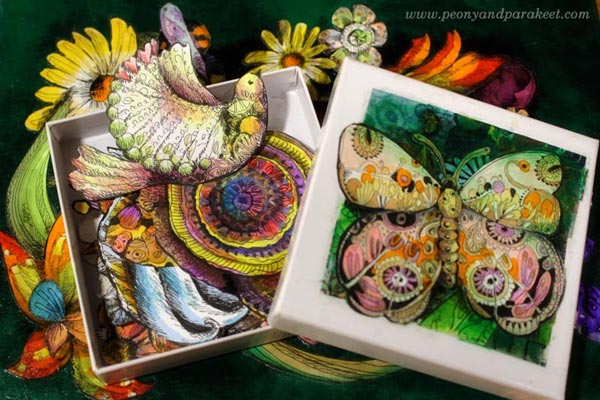
I started drawing these small separate little things in 2018, and have been creating them ever since. It’s so easy to pick a paper scrap and draw something simple, and then get enthusiastic about adding decorations and colors to it. I have several online courses where we draw these: Animal Inkdom, Magical Inkdom, Decodashery, and Doll World.
My animals are mostly drawn for the courses Animal Inkdom and Magical Inkdom, and I love them so much, that I have also printed copies of some of them. I have many boxes to choose from and I love to both use them and re-fill them.
For the first page, I selected a squirrel because it has pink and orange, and those have been my favorite colors recently.
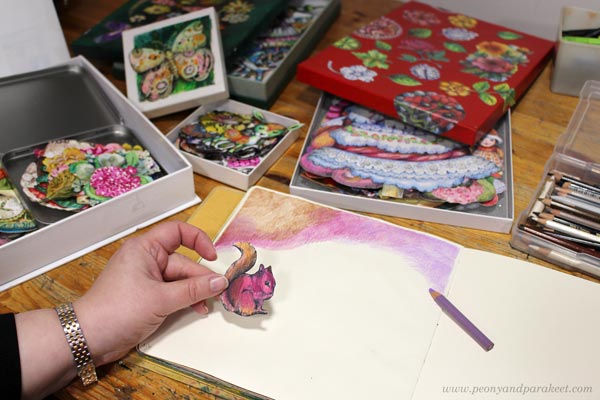
After selecting the animal, use its colors to color a small part of the page! Just color some layers freely (like in the course Intuitive Coloring). Don’t glue the animal yet, wait until you draw more and the story unfolds.
Picture Prompts – Go Beyond the Obvious!
We have a big nut bush in our garden and squirrels love it. So, my first thought was to draw some nuts for the squirrel. But that would be too ordinary and not fun at all. What if this squirrel would chase after Faberge eggs while others collect peanuts?
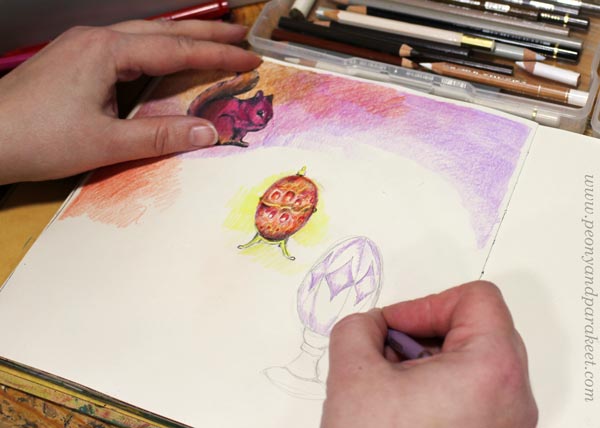
I love drawing decorated eggs. In Doll World, we draw a big egg, but this time I wanted the eggs to be small so I could fit many on one page.
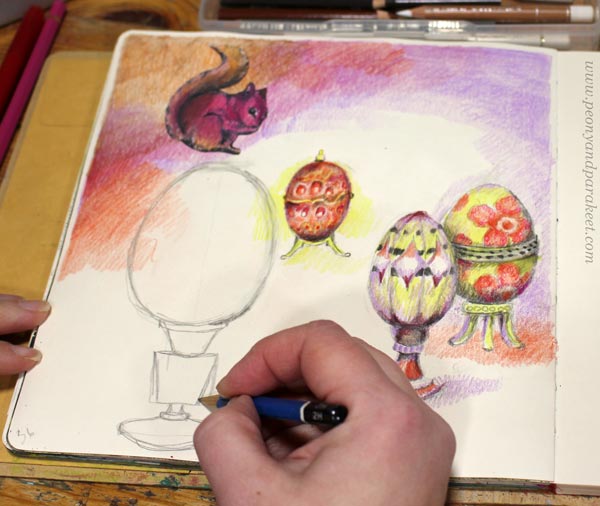
I made the eggs a bit different in size to make the page more interesting.
Static vs. “What If …”
When using the animal as a creative picture prompt, you want to find the story – not only the connection between the starting idea and the additions but also something surprising that keeps the inspiration going. If you only draw the ordinary, the picture easily becomes static – nothing is happening. Go for the extraordinary! Change the rules of reality, change the roles of the objects, make the animal speak – by drawing, you can create a world of your own. Ask: “What if?”
When I drew the first egg, it felt like just any object, but when I drew more of them, my imagination started working. Maybe the squirrel could sit on the biggest egg? And maybe the eggs could have a bigger role than to be just a decoration.

What if the scenery that I colored inside the biggest egg would leak into the surroundings?
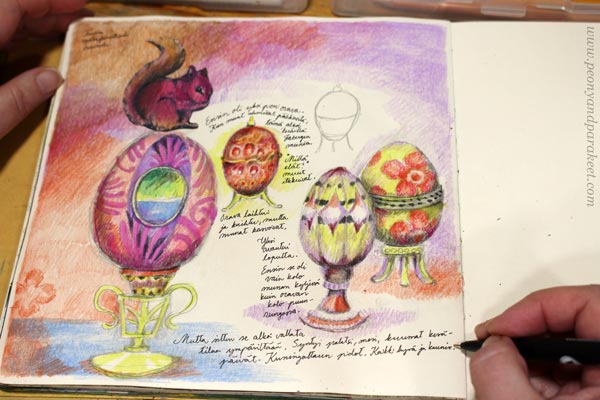
I wrote: “A palace was born, hot summer days came here, the queen (the squirrel) had a party, and all things good and beautiful came up.”
Then I drew more and completed the page inspired by the journaling.
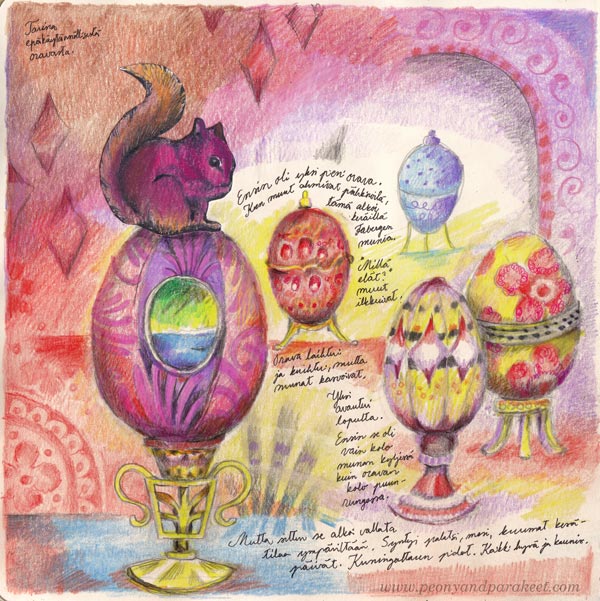
This is a story about an impractical squirrel who collected Faberge eggs instead of nuts and wasn’t much like other squirrels. But her eggs didn’t stay small. They grew and opened and created a place for her to live in.
“Isn’t that a story about every artist,” I realized after the page was finished.
Flying Wolf Art Journal Page
Let’s pick another animal and make the second page!
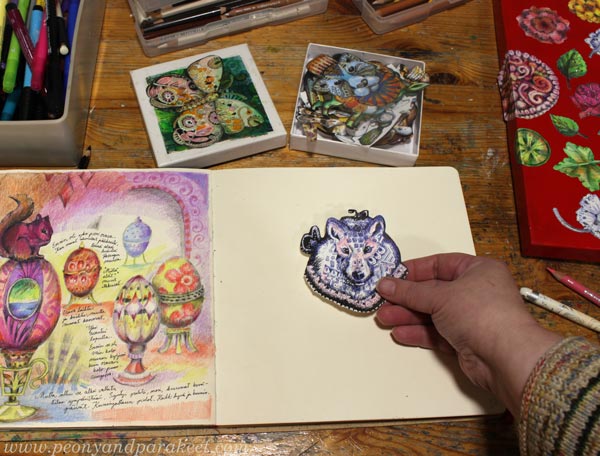
This wolf is the first little collage piece that I drew in 2018, so it’s time to give her a home. Decorating the animals was one of my core ideas for Animal Inkdom, so I can now color freely so that the decorations will continue to the background too.
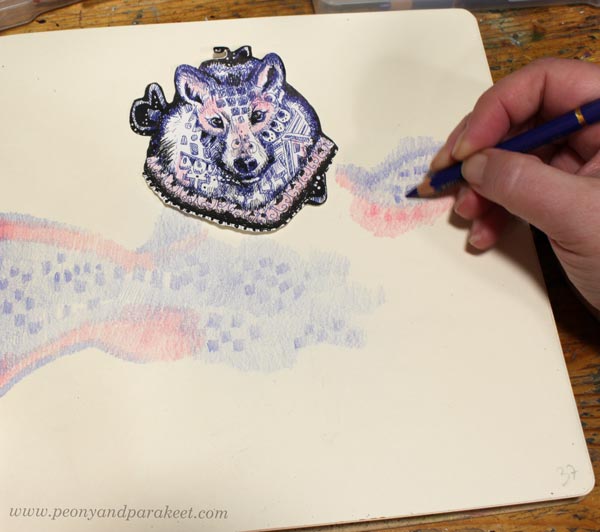
Again, I am using the colors that the animal has: blue, black, and pink. This way the collage piece doesn’t look separate from the rest of the page.
I wanted the wolf to fly, but not with furry wings. Could the wolf be partly a butterfly?
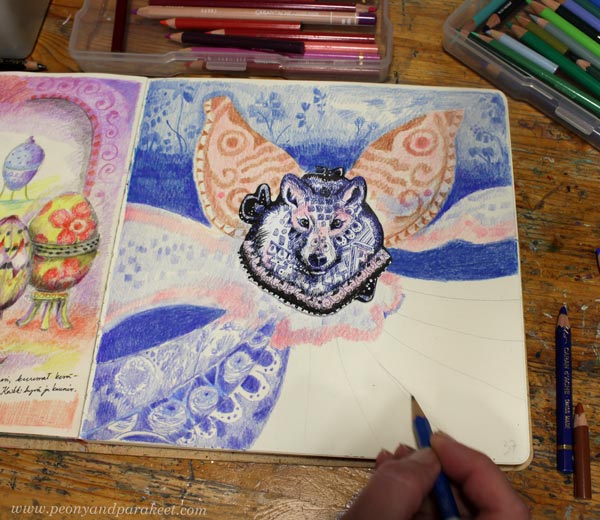
With the wolf, I felt a connection to my North Karelian origin. With the butterfly wings, I celebrated being a woman and loving delicate beautiful things.
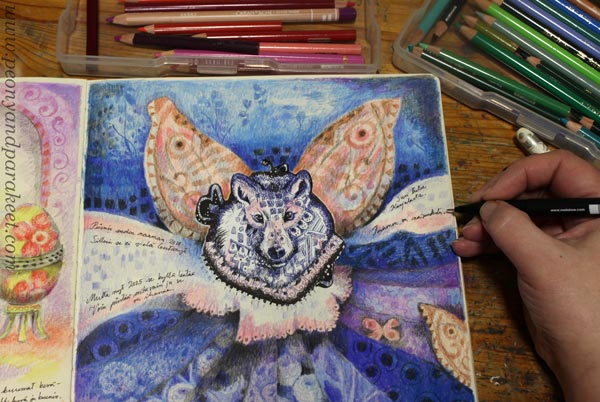
This wolf didn’t feel like a lonely one. So, I added a small butterfly and another bigger that is showing only partly on the right edge.
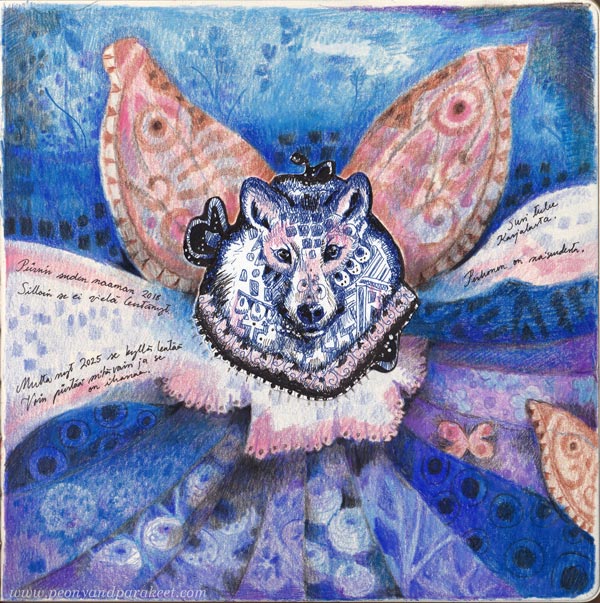
Back in 2018, my wolf didn’t fly yet, but it’s flying now! The more you draw, the more you can imagine!
Picture Prompts – Step by Step
- Pick the animal.
- Use the animal’s colors and patterns to get started.
- Ask: “What if …”
- Answer by drawing and journaling.
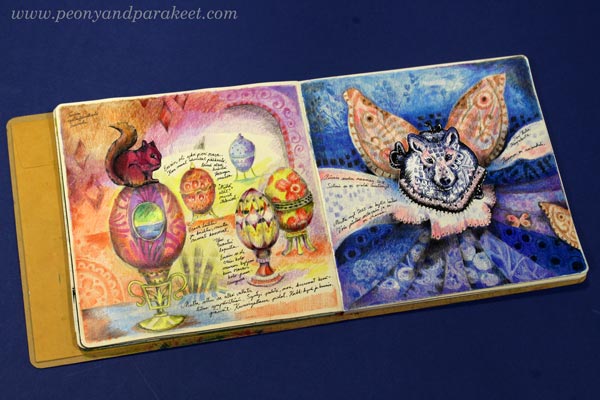
New in Development!
I have been making a new course that has a working title “Hearts and Stories.” I have already drawn quite many pieces for it. I collect them under a plastic plate that fits the side table of my studio. There I can see the whole collection at the same time, and think about what’s missing and how I will proceeed.
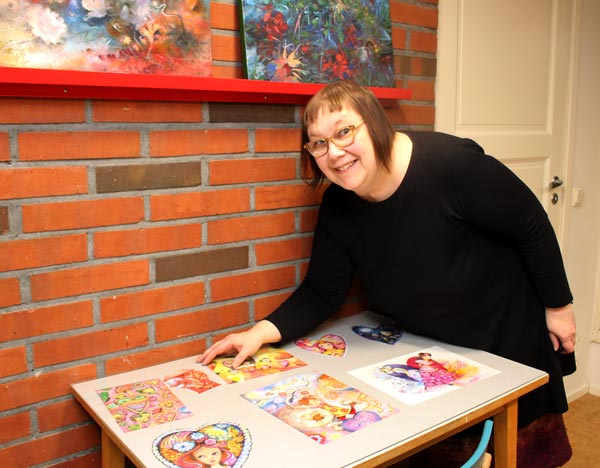
These drawings make me smile. My goal is that you too will smile when the course is running!
I want to be the advocate for drawing, because:
- If you only think, your imagination has limited capacity.
- If you only paint, you will stop playing and eventually run out of creative ideas.
- Drawing is important for any artist and for any human being.
What do you think?
Choosing the Word for 2025
Have you ever chosen the word for the new year and then happily forgotten it? Me too!
But last year, I had a word that stuck in my mind. It was “Integrate”. My word for 2025 is “Release”.
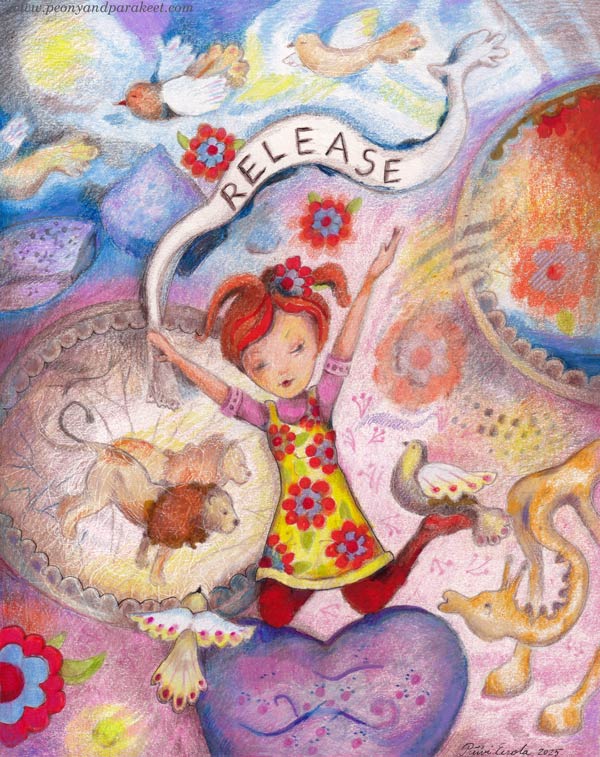
Here’s what I have learned about choosing the word!
Too Much Emotion, Too Little Impact
Some words appeal more to emotion, some to reason. Most often, I have chosen a word that has an emotional appeal. For example, “Imagination”, “Depth” or “Play“. There are plenty of these kinds of soft words, here are some common ones: “Joy”, “Courage”, “Inspire”, “Create”, “Focus”, “Nurture.”
These soft words that make your imagination run wild may seem like good choices, but they have this downside: when you’re busy working, your head is full of rational words. Emotional words don’t come to mind at that moment. This way, the practical connection to the word is missing.
My word for 2024 – “Integrate” – was a rather uninspiring word at first, but it became more and more inspiring over the course of the year. The idea was that even though I was doing a variety of art – drawing, painting and programming digital motion art – I could look for connections between different art forms so that I didn’t have to reinvent everything. I could also value more what I had created in previous years. This union of old and new worked out nicely, and with the word, I began to see my artistic career as a whole and not just an attempt to improve my artistry piece by piece.
The best thing about the word was that it didn’t describe the actual result but solved how to get there. So when I encountered problems, “Integrate” often offered at least a partial solution. That way the word came to mind repeatedly and helped me in situations when my inspiration was at its lowest.
Word That Changes Your Life
I think the best words are those that initiate change for the better. I have often chosen a word that is already familiar and doesn’t make me change anything. This year, my first candidate was “Elevate.” It sounded too soft, so I found a similar rational word “Upgrade.” But since I always try to improve my actions and the level of my art in general, I rejected “Upgrade” and chose “Release” instead.
To me, “Release” means letting go of what I’ve been holding in my heart and letting it come out. I want to give myself permission to be naive, naughty, brutal, overly cute, everything and anything, and start to blindly believe in my artistic vision. Release also means publishing what I’ve done openly and regularly and working with that in mind. Letting go and publishing is a bittersweet combination that really challenges me.
Release also means that I can let go of things if they hinder rather than help the cause.
Drawing the Word for 2025
Writing about the word is good, but I also wanted to process the word by drawing.

By drawing, you always find new dimensions. Even the hardest words become softer and create emotional connection.
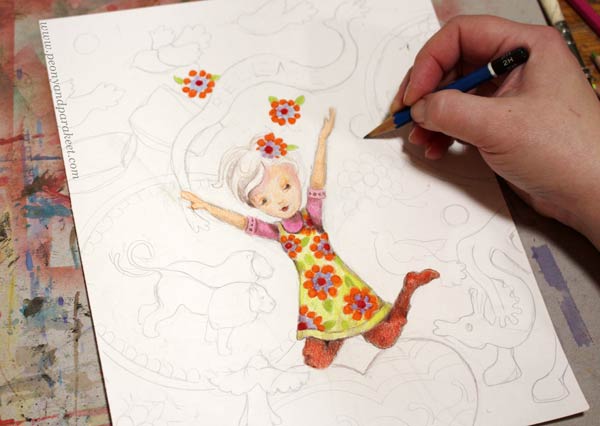
One thing leads to another. I love this way of drawing where the result remains a surprise for a long time.
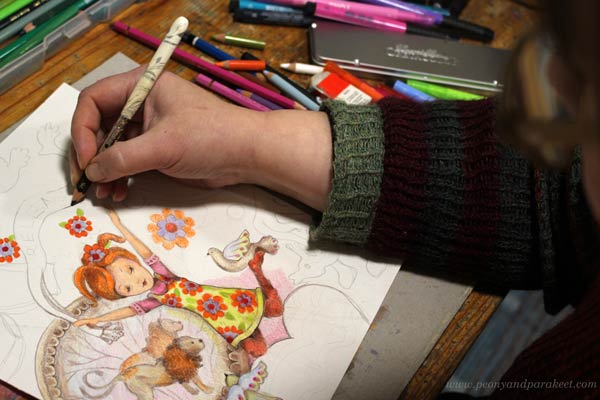
I combined colored pencils and markers here. I like the soft impression of colored pencils, but I used felt-tip pens in the highlights to intensify the colors.

When the drawing was half-finished I compared it to the little pieces I had drawn during the Christmas holiday.
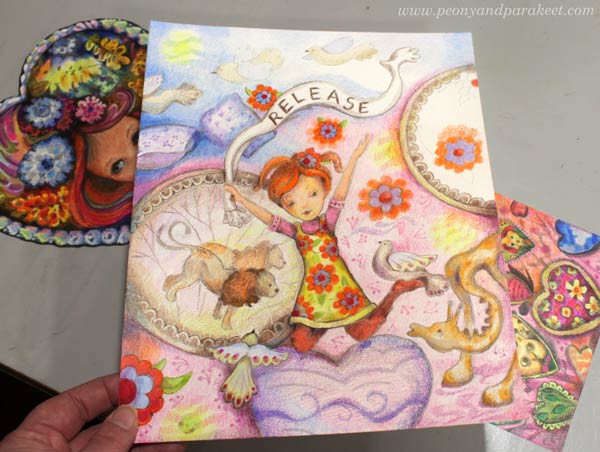
The colors still needs to be strengthened and details adjusted.
Finding the Connection with the Word
Even though this drawing isn’t very big, about letter size, there are a lot of details. I took many breaks and it took me about 3 days to finish the drawing. For the illustration that combines the right and the left brain, it’s important to find the connection between all the details and understand how they express the word.
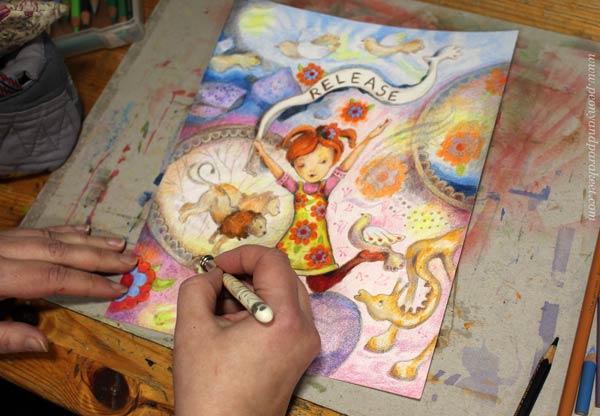
This drawing depicts my childhood in the 70s with plastic animals and daydreaming. The drawing feels revealing to me, although its style is playful.

Even if the picture feels a bit private, I want to share it with you: release, you know!
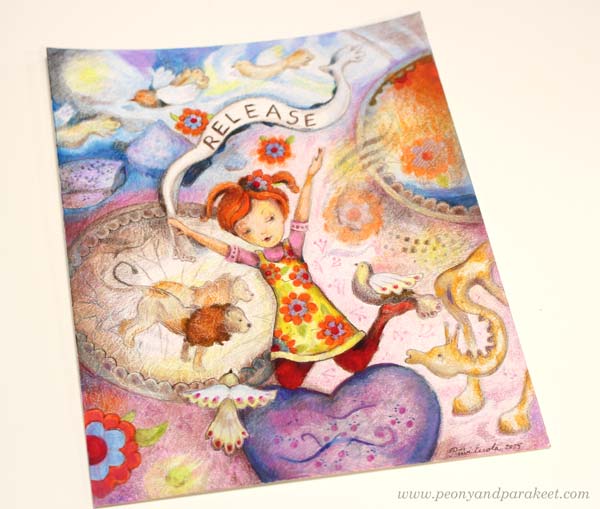
What’s your word for 2025?
Are you going to draw it?
What to Create with Colored Pencils? – Watch the Video!
This week I have a short inspirational video for you. I wanted to make a video that I can share on Instagram, so this has different portions than my videos usually are. You can watch it bigger by pressing the last icon on the menubar below the video.
Most of these drawings are made with regular colored pencils (or crayons as some call them) and some with watercolor pencils. I love both.
Coloring Freely on Blank Paper – Simple Start!
I am an advocate for coloring freely – starting with blank paper, adding colors on top of each other, and getting excited about what comes up. This doesn’t have to be anything difficult. Here’s an old picture from 2015 that I still find inspiring. You can illustrate your journaling with freely colored boxes.
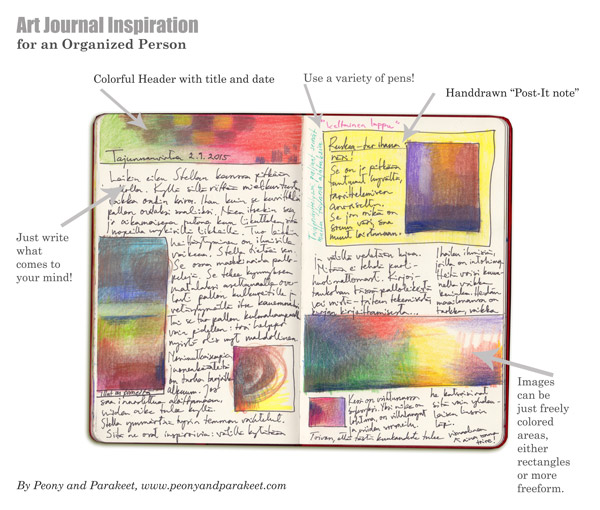
Children draw freely with colored pencils, but when they grow up and become “colored pencil artists” they need all kinds of references to get started. References are great for learning some techniques, but they don’t make anyone an artist. A big part of art is in our mind – how we open up and how we allow ourselves to break boundaries.
Growing Your Skills
My love for colored pencils is based on a promise that I have made for my inner child: I will color for you and help others to color for theirs. So even if I make oil paintings and media art too, colored pencils always have a special place in my heart.

So, welcome to my courses to improve your skills and expand your artistic thinking!
P.S. You can still sign up for Joyful Coloring!
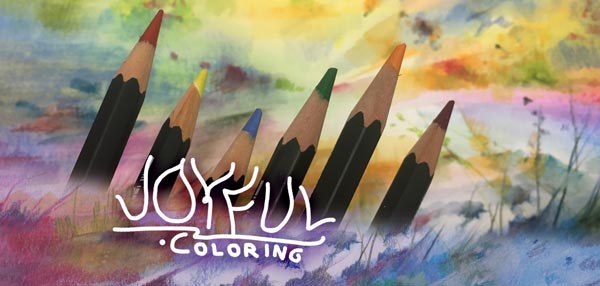
How to Add Depth When Coloring Freely
This week, we will color freely on a watercolor background and learn about adding depth to our colorings. I am using regular colored pencils, but you can also use watercolor pencils.

My drawing is inspired by the garden and the ornamental shapes of the plants, insects, and birds. So, let’s go deep in the garden and create lushness!
Quick Start with Watercolors
Blank paper can feel intimidating, but if you fill it first with watercolors, coloring is fun.
I was going through my paper pads when I found an unfinished watercolor painting.

It was just a background with random spots but the paper was smooth, just perfect for colored pencils. I think the paper is Arches Aquarelle Hot Press, nice and sturdy, 300 gsm/140 lbs thick.
I picked up my pencils and started drawing and let my inspiration come from the painted shapes.

I drew flowers, leaves, swirls, and all kinds of odd organic shapes that I would then later adjust.
Add Depth – Expand the Outlines!
When you draw, don’t just outline, but broaden the lines to form larger areas. For example, a black outline can be broadened so that it gradually gets lighter (“shadowing”) or so, that it remains dark and solid but expands to a larger and exciting shape.
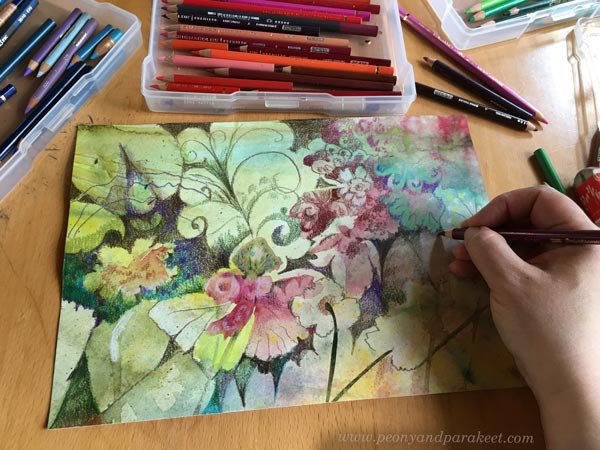
Dark and light should have clear differences so that you can point out separate areas: here’s dark, here’s light, here’s dark again, and so on.
Adding Depth is a Slow Process
When you are working without any references, you are on an adventure! What first looked like a flower, can become a butterfly after a while. Art is a shy fairy and it takes time to attract it.
In this intuitive coloring style, adding depth is a process where you slowly brighten or darken different areas. Start with a transparent layer, then add another one. When you have areas that haven’t been worked on with colored pencils yet, you can also use watercolors for layering.

Compared to accurately replicating a photo, this kind of free coloring may first feel much faster. But if you aim for depth, it’s not!
Add Depth – Find the Spirit!
At some point, your piece feels full and finished. But at this point, let me ask you a question:
Have you found the spirit of your piece?
Have you found something soulful that seems too gentle for this world?
Or is there something that cuts your heart and feels painful?
The depth in art is not only visual but something that evokes emotion.

In my piece, I discovered a spirit in the right upper corner. It’s not a flower or anything recognizable, but I felt it strongly.
After you have found the spirit, give more visibility to it. Make it so that it impacts the overall piece.
You Are the Sun
In your art, you are the sun. First, you can bring warmth to the piece by adding yellow. If you have areas that still take in watercolors, add a yellow wash over the greyish tones and let the warmth in.

Second, remember that you really are the sun. So, you can decide how the light travels and where the shadows are. You don’t need to calculate how the shadows should go like there would be one correct solution. Start deciding who deserves the sunshine, and who doesn’t! Who gets more color, and who will stay more in the shadow?
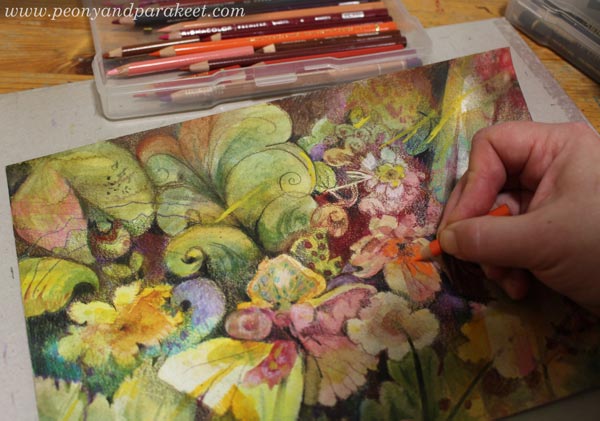
In nature, there are all kinds of reflections, and I find them artistically inspiring. Look at this photo that I took today from our garden pond!
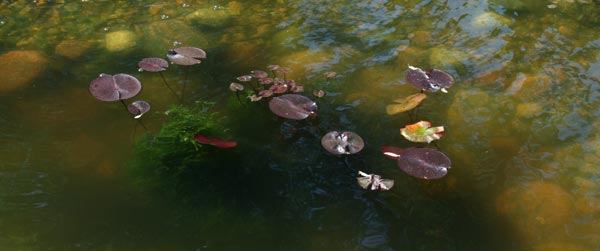
Playing with light, shadow, colors, and reflections is a lot of fun when you are creating freely. Remember that there’s no “shadow judge”, only “sun goddess” – you!
Add Depth – Force Yourself to Choose the Winners
Some people think about the composition all the time when they are creating, but I try to push that urge away as long as I can. You may have a lot of stuff on paper, but if you only highlight your favorites, balancing is easy. The problem is that you really have to choose!
Here, I have turned the paper upside down to get a different view of my work. That yellow flower looks very pretty, but the yellow butterfly shape near it is maybe even more attractive. Decisions, decisions!
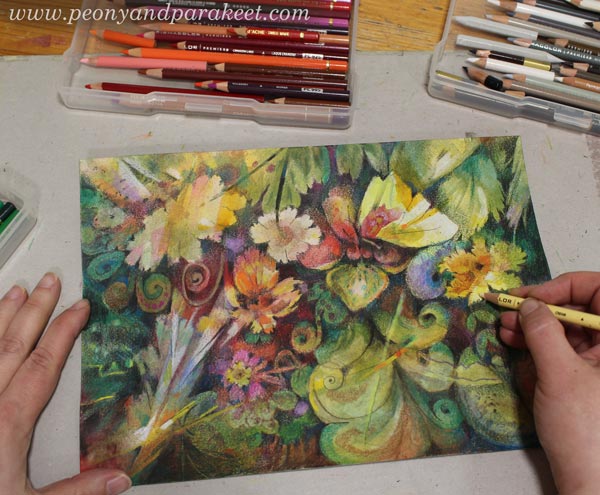
When I was at this point, I thought this was finished.
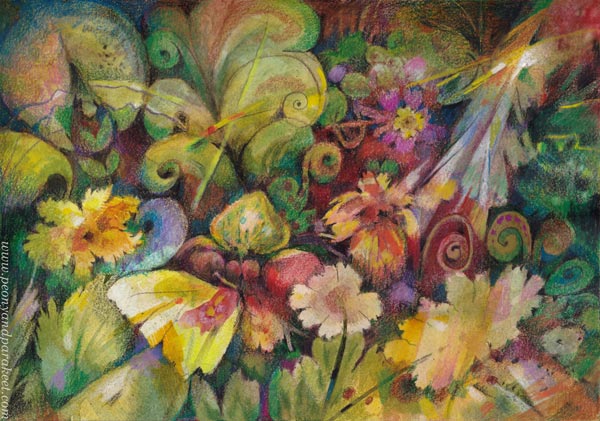
But when you want to add more depth, you want to reduce the competition for attention. I wanted to make the spirit in the upper right corner and the yellow butterfly clear winners even if it meant I pushed back many pretty things.
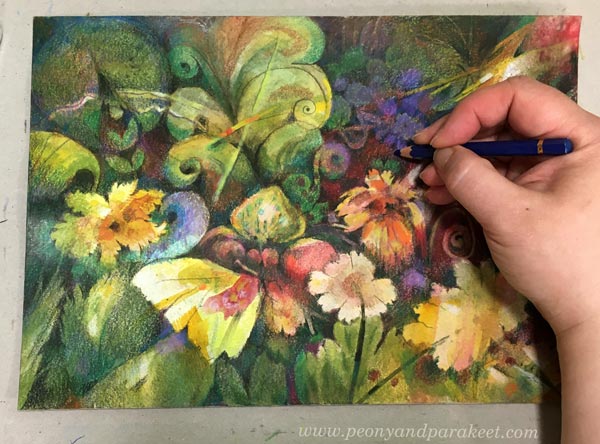
For example, the pink rose got toned down.
Room for Imagination
Things that are further away are blurry, like whispers, and things that are close, are sharp and louder. If everything shouts, and nothing whispers, the viewer will likely turn away. And vice versa, if everything only whispers, the viewer easily walks by.

If depth is lacking, you look at a wall and can’t see further. Depth is not only the impression but the imagination. With depth, you begin to imagine what more could be there. That’s especially why I want to add depth to my art whatever the subject is.
Learn more about watercolors and colored pencils together: See my course Freely Grown!